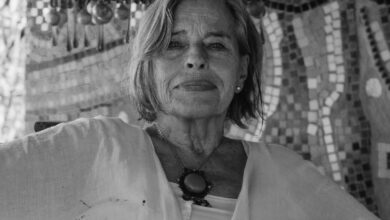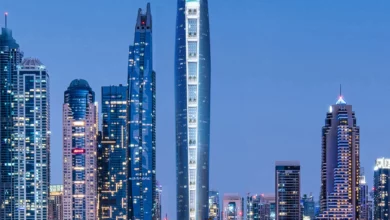Progress can be a messy thing. Take, for example, the Tower of Babel. According to the story, humankind, united after Noah’s flood, attempted to build a structure that would reach the heavens and serve as a shelter for the entire race. Dismayed by their lofty ambitions, a vengeful God punished mankind by scattering them across the planet, replacing their shared dialect with diverse languages to further hinder progress.
Today, one might gaze out upon Cairo’s endless urban sprawl and see progress. Or, if you’re artist Mohamed Abla, you might see something else entirely. “When we forget how to communicate, we lose the ability to act sensibly,” Abla says. “And the city turns into this weird structure of towers, all on the verge of collapsing.”
This “weird structure” is the focus of Abla’s latest exhibition, Cairo Towers, a series of bleak yet strangely soothing depictions of the city as the artist sees it. “My inspiration came from walking around the city, and contemplating the architecture. I began to see the buildings as individual characters, each with its own distinct personality.”
These personalities are clearly reflected in Abla’s paintings—with each of the displayed canvases depicting a lone structure against an empty sky, it’s remarkable how diverse the images are.
While Abla’s towers are more like amalgams of various Cairo structures rather than replicas, they manage to capture the city’s aesthetics flawlessly. Bare red-brick walls, crumbling colonial archways, neon blurs and makeshift advertising spaces—Abla brings them all together in his towering patchwork creations of familiar edifices, compressed, distorted, and worryingly unstable.
The base of a towering building is never visible, and the complete absence of any level surface only adds to the sense of insecurity. These are not structures designed out of a desire for luxury or even comfortable living. Rather, they are the result of a desperate and panic-stricken effort to escape whatever lurks below.
“The idea of a tower says a lot about how people feel about the city,” Abla explains. “People want to distance themselves from it, to rise above it.” With Cairo Towers, Abla feels he was able to explore that “attempt at ascension.”
“I’ve always been interested in the city, and concerned about the changes it undergoes,” he says, pointing out that these changes are “shared and reflected in buildings, on an architectural level, as well as a social one.”
Perhaps the most striking aspect of Abla’s exhibition is how lively the towers seem. Staring at the structures, there is no doubt that behind their collage of clashing fronts they are heavily, and uncomfortably, populated. Rooftop clusters of satellite dishes and strands of hanging laundry all imply a busy existence. Although unseen, the denizens of these ramshackle structures can definitely be felt—as Abla puts it, “You can hear them breathing.” Staring at the looming buildings, you get the disturbing impression that you’re being watched by a million quiet, peering eyes.
“I wanted to try something different, to have an exhibition with no people or human bodies,” says the artist, whose previous work often depicted huge, swirling crowds, family portraits and realistically congested street scenes. Cairo Towers may seem to be in stark contrast, but the spirit informing his art remains unchanged. Abla is an artist who has built his career on his adaptability and his ease with a staggering variety of styles.
However, that doesn’t necessarily mean he’s ready to move on just yet. His latest experiment has proven to be pleasantly fulfilling for Abla. “I’m not quite done with towers,” he says. “This is the first time in years that I’ve come across something that I feel I can pursue for a little while longer and further explore.”
Color also plays an important role in Abla’s new work. Some towers stand as a blinding concoction of neon and reflective panels, while other, more modest designs are left to crumble in simpler shades of black and grey.
And while the images are all striking, it is the larger canvases, which display some truly gargantuan hybrids of Cairene architecture, that carry the most weight. Bizarrely iconic, these images, blocks of vertical chaos against thick grey skies, convey a chilling reality of urban isolation. There are crowds behind the walls but, when it comes to the comfort and codependency of social interaction, they are just as invisible to themselves as they are to viewers on the other side of the canvas.
Abla claims some viewers have seemed to miss the point he was trying to make. “I personally thought the pieces were generally pessimistic, but people seem to think otherwise. Some have even told me they’d like to live in [these] buildings. They thought they looked ‘good,’” he laughs.
While it’s hard to believe anyone would look at Abla’s dystopian architecture as a potential fantasy home, the artist doesn’t seem to mind. “It was one of my goals, in that I wanted people to accept where they live. My intention wasn’t to say ‘Your homes are terrible and your lives are miserable.’ You need to give people a sense of optimism. That should be one of the goals of art.”
“This is our life, and we should find a way to live in it,” he says.
Cairo Towers will be on display at the Zamalek Art Gallery until 4 January, 2011.




